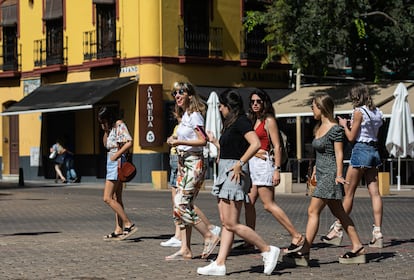Coronavirus infection rate among 20-29 group spikes nearly 40 points in a day, putting regions on alert
Eight of Spain’s territories are now registering more than 300 cases per 100,000 inhabitants among this age range and adolescents


Infections among young people are behind the latest spike seen in the coronavirus epidemiological curve in Spain. New contagions in the country had been falling since April, although in recent weeks the descent was slowing down more and more until on Wednesday the trend was broken and it began to rise once again. According to Health Ministry figures, on Wednesday the 14-day cumulative number of coronavirus cases per 100,000 inhabitants came in at 117.
The distribution of new cases, however, is highly irregular in terms of age groups, and is particularly focused on people in their 20s and adolescents aged between 12 and 19. The latter group currently has a 14-day incidence of more than 287 cases per 100,000 inhabitants. The 20-29 age group, meanwhile, has seen the incidence rise more than 40 points in a day to 293 cases.
There are eight regions in Spain where the incidence among young people is even higher: Andalusia, Asturias, Catalonia, Cantabria, La Rioja, Balearic Islands, Castilla y León and the Basque Country are currently above the average infection rate among adolescents, the 20-29 group, or both groups. Cantabria, for example, reached 727 cases per 100,000 in the 20-29 age group and is planning on closing nightlife venues once more.
This is a problem associated with the state of alarm, the end of the nighttime curfew, and the relaxation of restrictions for nightlifeDaniel López-Acuña, former director of emergencies at the World Health Organization
The central government’s health minister, Carolina Darias, called for “prudence,” while experts are warning that while the illness is much milder in young people, it can still cause serious symptoms among older people in their circle of family or friends if they are not fully vaccinated.
Young people are the perfect breeding ground for the virus, given that the vaccination campaign is still, for now, focusing on older groups. Youngsters lack any protection given that they have barely received any vaccine shots, and their social patterns and habits are serving to transmit the virus.
This is all happening as coronavirus restrictions are being relaxed on a global scale, and the reopening of businesses such as nightlife bars and clubs is contributing to this “explosion” of infections among adolescents and people in their 20s, according to the experts consulted by EL PAÍS.
The most striking case in Spain has been a mass outbreak in Mallorca, which has already affected more than a thousand students who were on the Balearic Island for end-of-term trips. But this episode is not the only one – the situation has been repeated, albeit on a smaller scale, all across Spain.
“We are going to see oscillations [in the contagions curve], but of course, we are convinced that the vaccination will mean that there is no great increase,” said Health Minister Darias on Wednesday, speaking after a meeting of the Inter-Territorial Council of the National Health System (CISNS), which brings together the central Health Ministry and the regions. “But we can’t become complacent because the virus is out there.” The minister called for “responsibility” among the population and for people “not to drop their guard.”

Daniel López-Acuña, a former director of emergencies at the World Health Organization (WHO), said that “a micro-wave is taking place among young people and it is having an influence on the general incidence. This is not a phenomenon linked to the mega-outbreak in Mallorca, this is a problem associated with the state of alarm, the end of the nighttime curfew, and the relaxation of restrictions for nightlife. What’s more, this has contributed to the sensation of false security given the supposed invulnerability of young people to the virus.” Nearly all of Spain is seeing the trend of infections rising among young people, which is in turn affecting the global figures. But some regions are being worse affected than others.
In Barcelona, for example, the positive cases among young people have quadrupled since the state of alarm was lifted in May. The Catalan health chief, Josep Maria Argimon, warned on Wednesday that the situation is “worrying,” although the rise in cases is not, for now, leading to an increase in hospital pressure. Magda Campins, the head of epidemiology at the Hospital Vall d’Hebron in Barcelona, agreed. “The explosive increase in cases worries me – not for the youngsters themselves, but rather because these people will interact in their homes with their parents and grandparents and not all of them are vaccinated nor do they have both their vaccination doses. If these young people are not prudent, in the coming days we could see their parents admitted to hospital.”
The latest report from the Health Ministry on variants puts the presence of the delta strain at 2.7% of the samples that have been sequenced
For now, Argimon has ruled out taking any steps backward in terms of the deescalation of coronavirus measures, although a decision has been taken to start vaccinating the under-30s in order to increase the protection among this group.
Campins also pointed out that the delta variant of the virus – first discovered in India, and which is up to 60% more contagious according to the European Center for Disease Prevention and Control (ECDC) – is also having a role in the spread in Catalonia. Last week, the regional administration estimated that the strain was responsible for more than 30% of the new infections, a percentage that Campins is now putting at more than 50%.
The latest report from the Health Ministry on variants puts the presence of the delta strain at 2.7% of the samples that have been sequenced, but that assumes a heterogenous spread of the strain throughout the regions.
Fernando Simón, the director of the Health Ministry’s Coordination Center for Health Alerts (CCAES), insisted on Monday that the rise in infections is not linked to the delta variant, but the experts disagree. “The scenario from the European Center for Disease Prevention and Control is that this summer the delta infections will be between 70% and 90%,” said López-Acuña. “And here we are also headed toward that.”

In the Balearics, there is concern over the rise in incidence among adolescents (349) and the 20-29 group (195), well above the average in the region of 95. One of the areas prompting most fears is Menorca, where 70 new infections were registered in a single day – many of them related to an outbreak at the Sant Joan de Ciutadella fiestas, which involve young people. At a time when cases are rising, the regional government has also opened up the vaccination campaign to 16- to 29-year-olds on the island of Mallorca – it has been available to the same group in Menorca, Ibiza and Formentera since Saturday.
In Andalusia, with 163 cases per 100,000 inhabitants, all age groups are currently above the Spanish average, although the trend is continuing a slow descent for the 12th consecutive day. Currently, the Seville municipality of Cantillana has more than 1,000 cases per 100,000 inhabitants, and mobility has been restricted in the area and non-essential activity has been halted. Córdoba, with a rate of 258, and Granada, with 207, are the Andalusian provinces with the highest incidence rates. These figures double for the 15-29 age group. Unlike in Catalonia or the Balearics, the regional health chief Jesús Aguirre stated on Tuesday that there will be no change to the vaccination plan, because the 30-40 age group – which is currently receiving its second dose – suffers more hospitalizations than the 15-29 age group.
Experts agree that the key to stopping the spread of infections is to track and trace positive cases and their close contacts in order to cut the chains of transmission, and to educate young people. “We shouldn’t stigmatize young people, but we have to be realistic,” said López-Acuña. “We need to explain to them the magnitude of this and how it is affecting them. Measures aimed at this group are not being taken. We need to intensify the testing among this sector of the population.” Immediate vaccination, he added, “is not the solution because the effect will arrive in a month.”
The priority for now, Campins explained, is to finish immunizing the most vulnerable sections of the population: “I’m concerned that the 16 to 25s will be vaccinated before the 29s. The important thing is to vaccinate those most at risk.”
In Spain, 25.3 million people have now received at least one jab, but the coverage is higher among the oldest groups. Among the 40-49 group, 34% are yet to get their first dose, while 26% of the 50-59 group is yet to receive their second injection. Among the 60-69 group, 53% are yet to receive their second shot either.
Coronavirus restrictions
Where the experts disagree is about whether or not there should be a ramping up of coronavirus restrictions. Campins suggested that until the rise in infections affects the hospital system and pressure on the country’s intensive care units (ICUs) spikes once more, there is no need to introduce new measures. López-Acuña, meanwhile, argued that “the relaxation of measures should be halted and there should be limits on social interaction.” He continued: “If we want to flatten the curve, we must stop the deescalation.”
In Spain, there are currently 2,375 Covid-19 patients, with an ICU occupation rate of 6.5% (there are 601 patients in a critical condition). Professionals agree that rather than there being stress on hospitals, it will instead fall on the primary healthcare system, which is facing a flood of positive cases and their close contacts, while also having to treat their regular patients.
According to the latest Health Ministry report, a total of 9,227 new infections have been detected while 46 Covid-19 fatalities were added to the overall death toll.
With reporting by Lucía Bohórquez, Mikel Ormazábal, Juan Navarro and Margot Molina.
English version by Simon Hunter.
Tu suscripción se está usando en otro dispositivo
¿Quieres añadir otro usuario a tu suscripción?
Si continúas leyendo en este dispositivo, no se podrá leer en el otro.
FlechaTu suscripción se está usando en otro dispositivo y solo puedes acceder a EL PAÍS desde un dispositivo a la vez.
Si quieres compartir tu cuenta, cambia tu suscripción a la modalidad Premium, así podrás añadir otro usuario. Cada uno accederá con su propia cuenta de email, lo que os permitirá personalizar vuestra experiencia en EL PAÍS.
¿Tienes una suscripción de empresa? Accede aquí para contratar más cuentas.
En el caso de no saber quién está usando tu cuenta, te recomendamos cambiar tu contraseña aquí.
Si decides continuar compartiendo tu cuenta, este mensaje se mostrará en tu dispositivo y en el de la otra persona que está usando tu cuenta de forma indefinida, afectando a tu experiencia de lectura. Puedes consultar aquí los términos y condiciones de la suscripción digital.
More information
Últimas noticias
Rowan Atkinson tops Netflix at 70: ‘He’s as funny as ever’
Israeli recognition of Somaliland stirs up the Gulf
Tiger Woods turns 50: Will he continue playing on the PGA Tour or take a back seat?
The surreal journey of James Nnaji, the Barcelona youth player selected in the NBA Draft who ended up in the NCAA
Most viewed
- Oona Chaplin: ‘I told James Cameron that I was living in a treehouse and starting a permaculture project with a friend’
- Reinhard Genzel, Nobel laureate in physics: ‘One-minute videos will never give you the truth’
- Sinaloa Cartel war is taking its toll on Los Chapitos
- Why the price of coffee has skyrocketed: from Brazilian plantations to specialty coffee houses
- Chevy Chase, the beloved comedian who was a monster off camera: ‘Not everyone hated him, just the people who’ve worked with him’










































